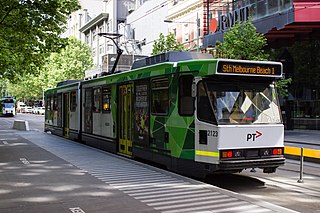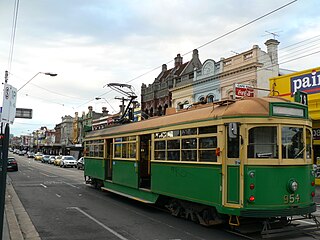
The Melbourne tramway network is a tramway system serving the city of Melbourne, Victoria, Australia. The tramway network is centred around the Melbourne central business district (CBD) and consists of approximately 1,700 tram stops across 24 routes. It is the largest operational urban tram network in the world and one of the most used, with more than 500 trams and 250 kilometres of double tram track. It served a patronage of 206 million over the year 2017-2018. Trams are the second most utilised form of public transport in Melbourne after the city's metropolitan commuter railway network.

Yarra Trams is the trading name of the operator of the tram network in Melbourne, Australia, which is owned by VicTrack and leased to Yarra Trams by the Victorian Department of Transport and Planning. The current franchise is operated by Keolis Downer. As at May 2014, Yarra Trams operate 487 trams, across 26 tram routes and a free City Circle tourist tram, over 1,763 tram stops. With 250 km (155.3 mi) of double track, Melbourne's tram network is the largest in the world.

Melbourne tram route 96 is operated by Yarra Trams on the Melbourne tram network from Brunswick East to St Kilda Beach. The 13.9 kilometre route is operated out of Southbank depot with C2, E class, and on occasion A class trams.

Melbourne tram route 109 is operated by Yarra Trams on the Melbourne tram network from Box Hill to Port Melbourne. The 19.3 kilometre route is operated out of Kew depot with A and C class trams.

Melbourne tram route 16 is operated by Yarra Trams on the Melbourne tram network from Melbourne University to Kew. The 20.2 kilometre route is operated out of Malvern depot with Z and D1 class trams.

Melbourne tram route 1 is operated by Yarra Trams on the Melbourne tram network from East Coburg to South Melbourne Beach. The 13.2-kilometre (8.2 mi) route is operated out of Brunswick depot with Z and B class trams.

Southbank tram depot is located in Southbank, a suburb of Melbourne, Victoria, Australia. Operated by Yarra Trams, it is one of eight tram depots on the Melbourne tram network.

Melbourne tram route 78 is operated by Yarra Trams on the Melbourne tram network from North Richmond to Balaclava. The 6.5 kilometre route is operated out of Kew depot with A class trams.

Melbourne tram route 79 was operated by Yarra Trams on the Melbourne tram network from North Richmond to St Kilda Beach. The 7.5 kilometre route was operated out of Glenhuntly depot with Z and A class trams.

Melbourne tram route 3 is operated by Yarra Trams on the Melbourne tram network from Melbourne University to Malvern East. The 14.9-kilometre (9.3 mi) route is operated out of Glenhuntly depot with Z and B class trams. Until 29 October 2023, route 3 operated as route 3a on weekends and diverted via St Kilda Beach.

Melbourne tram route 64 is operated by Yarra Trams on the Melbourne tram network from Melbourne University to Brighton East. The 18.1 kilometre route is operated out of Glenhuntly depot with Z and B class trams.

Melbourne tram route 24 was operated by Yarra Trams on the Melbourne tram network. It operated from Balwyn North to La Trobe Street West End in the Melbourne CBD. The 12.6 kilometre route was operated by A and C class trams from Kew depot.

Melbourne tram route 48 is operated by Yarra Trams on the Melbourne tram network from Balwyn North to Victoria Harbour. The 13.5-kilometre (8.4 mi) route is operated out of Kew depot with A and C class trams.

Melbourne tram route 11 is operated by Yarra Trams on the Melbourne tram network from West Preston to Victoria Harbour. The 13.4-kilometre (8.3 mi) route is operated out of Preston depot with E class trams.

The B-class Melbourne tram is a class of two-section, three-bogie articulated class trams that operate on the Melbourne tram network. Following the introduction of two B1-class prototype trams in 1984 and 1985, a total of 130 B2-class trams were built by Comeng, Dandenong.

The Z-class are single-unit bogie trams that operate on the Melbourne tram network. Between 1975 and 1983, 230 trams spanning three sub-classes were built by Comeng, Dandenong. The design was based on two similar Gothenburg tram models, and a prototype built by the Melbourne & Metropolitan Tramways Board. While the Z1 and Z2-class trams were very similar, the Z3-class had significant design changes.

Kew tram depot is located on the corner of Barkers Road and High Street, Kew, a suburb of Melbourne, Australia. Operated by Yarra Trams, it is one of eight tram depots on the Melbourne tram network.

Camberwell tram depot is located on Council Street, Hawthorn East, a suburb of Melbourne, Victoria, Australia. Opened in December 1929, it is operated by Yarra Trams. It is one of eight tram depots on the Melbourne tram network.

Brunswick tram depot is located on Sydney Road, Brunswick, a suburb of Melbourne, Victoria, Australia. It opened on 26 April 1936 in conjunction with the electrification of the Brunswick and North Melbourne Cable tram line. Operated by Yarra Trams, it is one of eight tram depots on the Melbourne tram network.
The Melbourne tram network began in 1884 with the construction of the Fairfield Horse Tramway. However, the purpose of the line was to increase land prices in the area, and it soon closed during the depression in 1890. The first genuine attempt to construct a tramway network was the construction of the Richmond cable tram line by the Melbourne Tramway & Omnibus Company in 1885. Over the next few years, 16 more cable tram lines were constructed, as well as numerous other horse tramways. The depression of the early 1890s slowed further expansion of the cable network. The first electric tram line was the Box Hill and Doncaster tramway which opened in 1889. This was a pioneering line in what was then the countryside and thus didn't receive much patronage. It closed in 1896. The next attempt at an electric tramway was Victorian Railways' St Kilda to Brighton line, which opened in 1906. Later that year, the North Melbourne Electric Tramway & Lighting Company opened lines to Essendon and Maribyrnong. Many local councils formed their own tramway trusts and built tramways within their own constituency. The most successful of these was the Prahran & Malvern Tramways Trust.





















